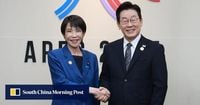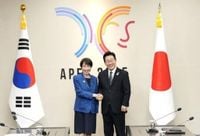On October 30, 2025, a new chapter in Northeast Asian diplomacy quietly unfolded in the historic city of Gyeongju, South Korea. Japanese Prime Minister Sanae Takaichi and South Korean President Lee Jae Myung met face-to-face for the first time since Takaichi assumed office just a week prior, marking a potentially pivotal moment for two countries whose relationship has long been marked by both shared interests and deep-seated grievances.
The meeting, originally slated for a brisk 20 minutes, stretched to nearly 45 minutes—a subtle but telling signal that both leaders had much to discuss and perhaps more common ground than anticipated. According to The Jiji Press, the leaders agreed to advance bilateral relations in a "future-oriented and stable manner," underscoring a joint desire to move past the historical disputes that have often cast a shadow over their interactions.
Lee Jae Myung set the tone early, emphasizing the urgency of strengthening ties in today’s volatile landscape. "In today’s rapidly changing international and trade environment, South Korea and Japan – as neighbouring countries with so many commonalities – must strengthen forward-looking cooperation more than ever before," Lee told Takaichi, as reported by South China Morning Post. His words reflected the growing realization that the challenges both countries face—ranging from economic turbulence to regional security threats—demand a united front.
Prime Minister Takaichi, meanwhile, was candid about the realities of proximity. "There are certain issues we disagree on precisely because we’re neighbours," she admitted, according to South China Morning Post. Yet she also struck a note of optimism: "We agreed that we should exercise our leadership to take care of them, and develop our relationships in a future-oriented, stable manner." Takaichi’s remarks were echoed in her comments to reporters after the meeting, where she said, "He gave me a very warm welcome. We had a very enjoyable exchange of views." (Kyodo News).
The summit was held on the sidelines of the Asia-Pacific Economic Cooperation (APEC) forum, a gathering that drew leaders from across the region, including China’s Xi Jinping and, until Thursday, US President Donald Trump. Against this backdrop, the Japan-South Korea meeting took on added significance, not only for the two countries involved but also for their mutual ally, the United States. Both leaders reaffirmed the importance of the trilateral partnership among Japan, South Korea, and the US, particularly in light of North Korea’s expanding military cooperation with Russia—a development that has rattled security planners in Tokyo, Seoul, and Washington alike (Jiji Press).
During the meeting, Lee highlighted the importance of common ground, especially under the current trade environment. As Reuters reported, Lee’s office noted that "it was more important than ever to strengthen bilateral ties given how the countries had much in common under the current trade environment." Takaichi, in turn, stressed that "future-oriented" development of relations would benefit both countries, and that cooperation between Tokyo, Seoul, and Washington was becoming increasingly important.
While the conversation was forward-looking, the ghosts of history were never far away. Relations between Japan and South Korea have long been strained by disputes stemming from Japan’s 1910-45 occupation of the Korean peninsula. Yet, in a notable departure from the usual script, the leaders did not directly broach these contentious historical issues during their talks. Kang Yu-jung, spokesperson for South Korea’s presidential office, confirmed that "Lee and Takaichi did not directly mention issues related to Japan's colonial rule of Korea during the meeting" (Reuters).
Instead, the focus remained on cooperation and mutual understanding. Lee offered a poignant analogy, likening the two countries to family members who, due to their closeness, sometimes hurt each other. "The two countries are so close physically that they sometimes hurt each other like family members," Lee remarked—a sentiment, Kang said, that Takaichi shared. In a gesture of goodwill, Lee presented Takaichi with Korean seaweed and cosmetics, a small but meaningful token of hospitality (Reuters).
Both leaders also agreed to revive and continue "shuttle diplomacy"—regular reciprocal visits by their heads of state, a practice that had lapsed during periods of heightened tension. "I want to communicate well (with Lee) by using shuttle diplomacy," Takaichi said, signaling her intent to keep the channels of dialogue open and active (Jiji Press).
For Takaichi, the meeting was an important early test of her diplomatic skills. Having taken office only the week before, she stepped into a role fraught with expectation and historical baggage. Yet, the extension of the meeting—far beyond the allotted time—suggested a willingness on both sides to engage in substantive discussion. "It’s beneficial for both countries to develop their ties in a future-oriented and stable manner, based on the foundation that has been built up to date," Takaichi said during the meeting (Jiji Press).
Lee, for his part, expressed confidence that collaboration could help resolve not only bilateral but also broader regional and international challenges. "We will be able to resolve both domestic and international issues by sharing our experiences and working together," he responded (Jiji Press).
The summit unfolded in a region where the strategic environment is shifting rapidly. North Korea’s growing ties with Russia have raised alarms, and both Japan and South Korea find themselves navigating an increasingly complex web of alliances and rivalries. The presence of other major powers at the APEC summit underscored the stakes: stability and cooperation between Tokyo and Seoul are seen as essential not just for their own security, but for the broader Indo-Pacific region.
Observers have noted that while the meeting did not resolve the longstanding historical disputes, it set a constructive tone for future engagement. The deliberate avoidance of direct discussion on Japan’s colonial legacy may have been a tactical move, allowing both sides to focus on areas of common interest without becoming mired in intractable issues—at least for now.
For everyday citizens in both countries, the hope is that this thaw at the top will trickle down, easing tensions that have sometimes spilled over into trade disputes, cultural boycotts, and public protests. The leaders’ emphasis on "forward-looking cooperation" and "stable, future-oriented relations" may sound like diplomatic boilerplate, but in a region where old wounds run deep, such language can be the first step toward genuine reconciliation.
As the world watched, Takaichi and Lee’s extended conversation in Gyeongju offered a glimpse of what might be possible when leaders choose pragmatism over grievance. While the road ahead is sure to be bumpy, the willingness to talk—and to listen—could prove to be the most valuable diplomatic currency of all.

